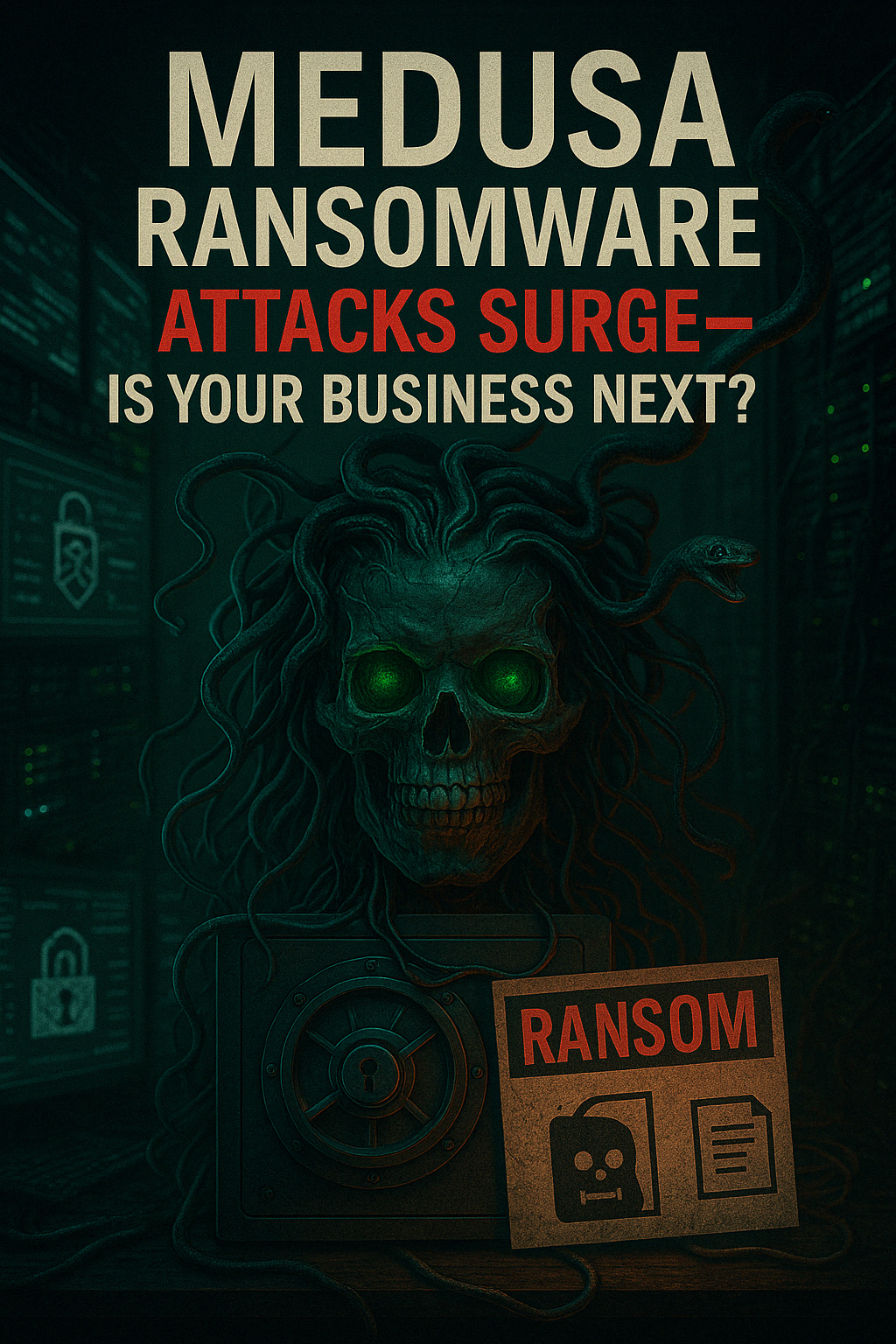
Medusa ransomware has been a notable and evolving threat in the cybersecurity landscape since its emergence in 2021. This ransomware-as-a-service (RaaS) group transitioned from a closed, centrally controlled operation to an affiliate-based model. However, the core Medusa developers still retain control over critical operations, such as ransom negotiations.
Medusa employs a double extortion strategy, encrypting victim data and threatening to publicly release the exfiltrated data if the ransom is not paid. This approach has made Medusa a formidable force, impacting over 300 victims across diverse sectors, including healthcare, insurance, technology, and manufacturing.
The group’s tactics are highly sophisticated, involving initial access brokers (IABs) to infiltrate networks. They use phishing campaigns and exploit unpatched software vulnerabilities. Once inside, they leverage living-off-the-land (LOTL) techniques, utilizing legitimate tools like PowerShell and Windows Management Instrumentation (WMI) to evade detection and maintain persistence.
Medusa’s ability to adapt and evolve its tactics, techniques, and procedures (TTPs) ensures it remains a significant threat to organizational security.
Recent Attacks and Their Impact

Overview of Affected Sectors
The Medusa ransomware has caused widespread disruptions across various critical sectors, showcasing its versatility and the broad scope of its attacks. Healthcare providers, non-profit organizations, financial institutions, government agencies, and companies in the technology and manufacturing industries have all been targeted.
This diverse range of victims highlights the group’s ability to adapt and exploit vulnerabilities across different types of organizations.
In the healthcare sector, Medusa’s attacks have led to significant disruptions in patient care and operational continuity. The encryption of critical medical records and the disruption of hospital systems pose life-threatening consequences, making these attacks particularly alarming. Similarly, in the financial sector, Medusa has compromised sensitive financial data and disrupted banking services, targeting banks and other financial institutions.
Government agencies have also suffered, with Medusa actors exploiting vulnerabilities in public-facing applications to gain initial access. These breaches have resulted in the compromise of sensitive government data and interruptions to public services.
The impact on these sectors goes beyond financial losses; it also affects reputation, as public trust in these institutions can be significantly damaged.
Case Studies of Notable Incidents
One notable incident involved a large healthcare provider attacked in early 2025. The Medusa actors exploited an unpatched vulnerability in the provider’s Microsoft Exchange Server to gain initial access to the network.
Using remote management and monitoring (RMM) software like AnyDesk, they moved laterally within the network and exfiltrated sensitive patient data. The attackers then encrypted critical systems, including those essential for patient care, and demanded a ransom of $1 million. This attack led to the temporary shutdown of several hospital departments and caused significant delays in patient treatments.
Another incident targeted a financial institution using the Bring Your Own Vulnerable Driver (BYOVD) technique. The attackers deployed a signed vulnerable driver to disable the institution’s security software, enabling them to move undetected within the network. They exfiltrated financial data and encrypted key systems, including those related to online banking and transaction processing.
The institution faced a ransom demand of $5 million and experienced substantial downtime, which disrupted its ability to provide services to customers.
These case studies underscore the sophisticated and devastating nature of Medusa ransomware attacks, emphasizing the urgent need for robust cybersecurity measures to safeguard against such threats.
Tactics, Techniques, and Procedures (TTPs) Used in Recent Attacks

Initial Access and Spread
Medusa ransomware actors employ a variety of sophisticated methods to gain initial access to their targets. One of their primary techniques involves recruiting initial access brokers (IABs) from cybercriminal forums and marketplaces. These IABs use phishing campaigns and exploit unpatched software vulnerabilities to infiltrate victim systems.
For example, Medusa actors have exploited vulnerabilities such as the ScreenConnect vulnerability (CVE-2024-1709) and the Fortinet EMS SQL injection vulnerability (CVE-2023-48788) to gain entry into networks. Once inside, they rely on living-off-the-land (LOTL) techniques and legitimate tools to avoid detection. They leverage tools like PowerShell, Windows Command Prompt (cmd.exe), and Windows Management Instrumentation (WMI) for network and filesystem enumeration.
Remote access software such as AnyDesk, ConnectWise, and PDQ Deploy is also used to move laterally through the network. Their choice of tools is often tailored to what is already available within the victim’s environment. Additionally, Medusa actors utilize PsExec to execute scripts and commands on remote machines, often with SYSTEM-level privileges. This includes creating new firewall rules and modifying registry settings to allow Remote Desktop connections and enable WMI access.
To further their attack, they use Mimikatz for Local Security Authority Subsystem Service (LSASS) dumping, enabling them to harvest credentials and facilitate deeper lateral movement within the network.
Encryption Tactics and Extortion Methods
After gaining access and spreading throughout the network, Medusa actors deploy their ransomware to encrypt victim files. The ransomware, known as `gaze.exe`, employs AES-256 encryption and appends the `.medusa` extension to encrypted files. To ensure the system remains operational, the encryption process avoids files with certain extensions such as `.dll`, `.exe`, and `.lnk`, and skips specific folder paths like `\Windows\`, `\Program Files\`, and `\ProgramData\`.
Medusa actors use a double extortion strategy, where they not only encrypt the victim’s data but also exfiltrate it. They then threaten to publicly release the stolen data unless the ransom is paid. The exfiltrated data is stored on Medusa-controlled servers and is used to pressure victims further. Additionally, the group operates a data leak site where stolen data is auctioned off to third parties if the ransom remains unpaid, adding another layer of coercion.
The attack culminates with the delivery of a ransom note, typically named `!!read_me_medusa!!.txt`. This note provides instructions on how to pay the ransom to decrypt the files. Ransom demands vary widely, and victims who pay may still face further extortion attempts, suggesting the possibility of triple extortion tactics.
Responses and Recommendations for Organizations

Immediate Actions to Take Post-Infection
If an organization suspects or confirms a Medusa ransomware infection, immediate action is necessary to minimize damage and prevent further spread. The first step is to isolate the infected systems from the rest of the network to prevent lateral movement.
This can be done by disconnecting the affected systems from the network and disabling any remote access services such as RDP, VPN, and SSH.
Organizations should also activate their incident response plans, which include notifying relevant stakeholders, including law enforcement agencies like the FBI and cybersecurity agencies such as CISA and MS-ISAC. Reporting the incident can provide access to valuable resources and guidance on how to handle the situation effectively
Restoring from offline backups is a critical step in recovering from a ransomware attack. It is essential to ensure that these backups are not connected to the infected network and are stored securely.
Regularly testing backup restoration processes is also vital to verify data integrity and minimize downtime during recovery.
Additionally, organizations should conduct a thorough forensic analysis to identify the entry point of the attack and any other compromised systems. This involves monitoring network traffic, analyzing system logs, and using tools like Endpoint Detection and Response (EDR) solutions to detect and respond to suspicious activities.
Long-term Strategies to Prevent Ransomware Attacks
To prevent future Medusa ransomware attacks, organizations must adopt a robust and multi-layered cybersecurity strategy. One of the most critical steps is to ensure that all operating systems, software, and firmware are regularly updated and patched to address known vulnerabilities.
This includes prioritizing patches for critical vulnerabilities that Medusa actors are known to exploit, such as CVE-2024-1709 and CVE-2023-48788.
Implementing network segmentation is another key strategy. Dividing the network into segments can limit the lateral movement opportunities for attackers, reducing the potential impact of an infection.
Strict access controls between network segments containing sensitive data should also be enforced.
Enforcing Multi-Factor Authentication (MFA) on all accounts, especially those with administrative privileges, is essential. Adopting the principle of least privilege ensures that users have only the access necessary for their roles, further reducing the risk of unauthorized access and lateral movement.
Organizations should also deploy Endpoint Detection and Response (EDR) solutions to monitor and respond to suspicious activities. Utilizing application allowlisting to prevent unauthorized applications from executing can add an additional layer of security. Regular email filtering and employee training on recognizing phishing and social engineering attacks are also important in preventing initial access via phishing campaigns.
Finally, maintaining regular, offline backups of critical data is vital for ensuring recovery in the event of an attack. Regularly testing backup restoration processes helps verify data integrity and minimizes downtime during recovery. By combining these strategies, organizations can significantly enhance their cybersecurity posture and reduce the risk of falling victim to Medusa ransomware attacks.
Conclusion
The Medusa ransomware presents a serious and evolving threat to organizations across various industries. Key aspects to note include the group’s reliance on initial access brokers, exploitation of unpatched vulnerabilities, and the use of living-off-the-land techniques to bypass detection mechanisms.
Medusa actors employ double extortion methods, encrypting data while also threatening to leak exfiltrated information if the ransom is not paid. To defend against such attacks, organizations should focus on patching vulnerabilities, network segmentation, and implementing comprehensive security measures like multi-factor authentication and regular backups. In the event of an infection, immediate steps such as isolating affected systems and restoring data from backups are critical.
By maintaining a proactive and informed stance, organizations can drastically reduce the likelihood of becoming victims of Medusa ransomware and minimize the potentially devastating consequences.
